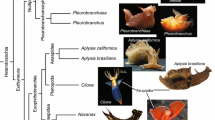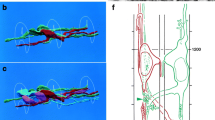Abstract
In locomotory systems, the central pattern generator and motoneuron output must be modulated in order to achieve variability in locomotory speed, particularly when speed changes are important components of different behavior acts. The swimming system of the pteropod molluscClione limacina is an excellent model system for investigating such modulation. In particular, a system of central serotonergic neurons has been shown to be intimately involved in regulating output of the locomotory pattern generator and motor system ofClione. There are approximately 27 pairs of serotonin-immunoreactive neurons in the central nervous system ofClione, with about 75% of these identified. The majority of these identified immunoreactive neurons are involved in various aspects of locomotory speed modulation. A symmetrical cluster of pedal serotonergic neurons serves to increase wing contractility without affecting wing-beat frequency or motoneuron activity. Two clusters of cerebral cells produce widespread responses that lead to an increase in pattern generator cycle frequency, recruitment of swim motoneurons, activation of the pedal serotonergic neurons and excitation of the heart excitor neuron. A pair of ventral cerebral neurons provides weak excitatory inputs to the swimming system, and strongly inhibits neurons of the competing whole-body withdrawal network. Overall, the serotonergic system inClione is compartmentalized so that each subsystem (usually neuron cluster) can act independently or in concert to produce variability in locomotory speed.
Similar content being viewed by others
References
Arshavsky, Y. I., Beloozerova, I. N., Orlovsky, G. N., Panchin, Y. V. and Pavlova, G. A. (1985a) Control of locomotion in marine molluscClione limacina. I. Efferent activity during actual and fictitious swimming.Exp. Brain Res.,58, 255–262.
Arshavsky, Y. I., Beloozerova, I. N., Orlovsky, G. N., Panchin, Y. V. and Pavlova, G. A. (1985b) Control of locomotion in marine molluscClione limacina. II. Rhythmic neurons of pedal ganglia.Exp. Brain Res.,58, 263–272.
Arshavsky, Y. I., Beloozerova, I. N., Orlovsky, G. N., Panchin, Y. V. and Pavlova, G. A. (1985c) Control of locomotion in marine molluscClione limacina. III. On the origin of locomotory rhythm.Exp. Brain Res.,58, 273–284.
Arshavsky, Y. I., Beloozerova, I. N., Orlovsky, G. N., Panchin, Y. V. and Pavlova, G. A. (1985d) Control of locomotion in marine molluscClione limacina. IV. Role of type 12 interneurons.Exp. Brain Res.,58, 285–293.
Arshavsky, Y. I., Deliagina, T. G., Orlovsky, G. N., Panchin, Y. V., Pavlova, G. A. and Popova, L. B. (1986) Control of locomotion in marine molluscClione limacina. VI. Activity of isolated neurons of pedal ganglia.Exp. Brain Res.,63, 106–112.
Arshavsky, Y. I., Orlovsky, G. N., Panchin, Y. V. and Pavlova, G. A. (1989) Control of locomotion in marine molluscClione limacina. VII. Reexamination of type 12 interneurons.Exp. Brain Res.,78, 398–406.
Arshavsky, Y. I., Deliagina, T. G., Gelfand, I. M., Orlovsky, G. N., Panchin, Y. V., Pavlova, G. A. and Popova, L. B. (1990) Neural control of heart beat in the pteropod molluscClione limacina: coordination of circulatory and locomotor systems.J. Exp. Biol.,148, 461–475.
Brown, T. G. (1914) On the nature of the fundamental activity of the nervous centers; together with an analysis of the conditioning of rhythmic activity in progression, and a theory of the evolution of function in the nervous system.J. Physiol., (Lond.),48, 18–46.
Croll, R. P., Kovac, M. P., Davis, W. J. and Matera, E. M. (1985) Neural mechanisms of motor program switching inPleurobranchaea: Role of the paracerebral neurons and other identified brain neurons.J. Neurosci.,5, 64–71.
Gelperin, A. (1981) Synaptic modulation by identified serotonin neurons. In:Serotonin Neurotransmitters and Behaviour, ed. B. L. Jacobs and A. Gelperin, pp. 288–304. Cambridge, MA: MIT Press.
Gillette, R. and Davis, W. J. (1977) The role of the metacerebral giant neuron in the feeding behavior ofPleurobranchaea.J. Comp. Physiol.,116, 129–159.
Goldstein, R., Kistler, H. B., Steinbusch, H. W. M. and Schwartz, J. H. (1984) Distribution of serotonin-immunoreactivity in juvenileAplysia.Neuroscience,11, 535–547.
Granzow, B. and Kater, S. B. (1977) Identified higher-order neurons controlling the feeding motor program ofHelisoma.Neuroscience,2, 1049–1063.
Kabotyansky, E. A. and Sakharov, D. A. (1990) Neuronal correlates of serotonin-dependent behavior in pteropod molluscClione limacina.J. Higher Nerv. Activ.,40, 739–753 (in Russian).
Lalli, C. M. (1967)Studies on the Structure and Biology of Two Gymnosomatous Pteropods, Clione limacinaAgersborg and Curcibranchaea machrochira (Meisenheimer). Ph.D. Thesis, University of Washington, Seattle, Washington.
Lalli, C. M. and Gilmer, R. W. (1989)Pelagic Snails. The Biology of Holoplanktonic Gastropod Mollusks. Stanford: Stanford Univ. Press.
Longley, R. D. and Longley, A. J. (1986) Serotonin immunoreactivity of neurons in the gastropodAplysia californica.J. Neurobiol.,17, 339–358.
McPherson, D. R. and Blankenship, J. E. (1991) Neural control of swimming inAplysia brasiliana. III. Serotonergic modulatory neurons.J. Neurophysiol.,66, 1366–1379.
Norekian, T. P. and Satterlie, R. A. (1995) An identified cerebral interneuron initiates different elements of prey capture behavior in the pteropod mollusc,Clione limacina.Invertebr. Neurosci.,1, 235–248.
Norekian, T. P. and Satterlie, R. A. (1996a) Whole-body withdrawal circuit and its involvement in the behavioral hierarchy of the molluscClione limacina.J. Neurophysiol.,75, 529–537.
Norekian, T. P. and Satterlie, R. A. (1996b) Cerebral serotonergic neurons reciprocally modulate swim and withdrawal neural networks in the mollusc,Clione limacina.J. Neurophysiol.,75, 538–546.
Ono, J. K. and McCaman, R. E. (1984) Immunocytochemical localization and direct assays of serotonin-containing neurons inAplysia.Neuroscience,11, 549–560.
Sakharov, D. A. and Kabotyansky, E. A. (1986) Integration of behavior of a pteropod mollusc by dopamine and serotonin.Zh. Obshch. Biol.,47, 234–245 (in Russian).
Satterlie, R. A. (1985) Reciprocal inhibition and postinhibitory rebound produce reverberation in a locomotor pattern generator.Science,229, 402–404.
Satterlie, R. A. (1991) Electrophysiology of swim musculature in the pteropod molluscClione limacina.J. Exp. Biol.,159, 285–301.
Satterlie, R. A. (1993) Neuromuscular organization in the swimming system of the pteropod molluscClione limacina.J. Exp. Biol.,181, 119–140.
Satterlie, R. A. (1995) Serotonin modulation of swimming speed in the pteropod mollusc,Clione limacina. II. Peripheral modulation.;J. Exp. Biol.,198, 905–916.
Satterlie, R. A. and Norekian, T. P. (1995) Serotonin modulation of swimming speed in the pteropod mollusc,Clione limacina. III. Cerebral neurons.J. Exp. Biol.,198, 917–930.
Satterlie, R. A. and Spencer, A. N. (1985) Swimming in the pteropod mollusc,Clione limacina.J. Exp. Biol.,116, 205–222.
Satterlie, R. A., Goslow, G. E. and Reyes, A. (1990) Two types of striated muscle suggest two-geared swimming in the pteropod molluscClione limacina.J. Exp. Zool.,255, 131–140.
Satterlie, R. A., Norekian, T. P., Jordan, S. and Kazilek, C. J. (1995) Serotonin modulation of swimming speed in the pteropod mollusc,Clione limacina. I. Serotonin immunoreactivity in the central nervous system and wings.J. Exp. Biol.,198, 895–904.
Wagner, N. (1885)Die Wirbellosen des Weissen Meeres: Zoologische Forschungen an der Kuste des Solowetzkischen Meerbusens in den Sommermonaten der Jahre. Leipzig: Verlag Von Wilhelm Engelmann, p. 168.
Weiss, K. R., Cohen, J. L. and Kupfermann, I. (1978) Modulatory control of buccal musculature by a serotonergic neuron (metacerebral cell) inAplysia.J. Neurophysiol.,41, 181–203.
Author information
Authors and Affiliations
Corresponding author
Rights and permissions
About this article
Cite this article
Satterlie, R.A., Norekian, T.P. Modulation of swimming speed in the pteropod mollusc,Clione limacina: Role of a compartmental serotonergic system. Invertebrate Neuroscience 2, 157–165 (1996). https://doi.org/10.1007/BF02214171
Issue Date:
DOI: https://doi.org/10.1007/BF02214171




